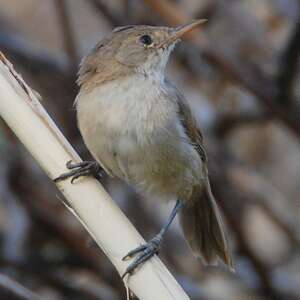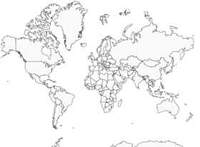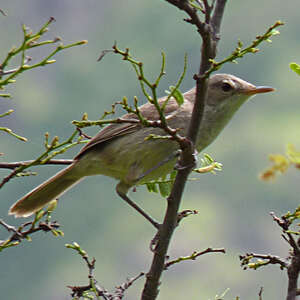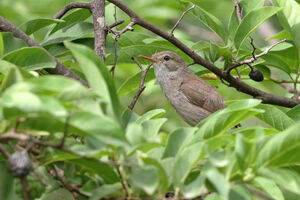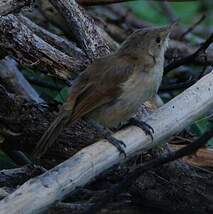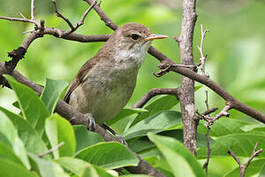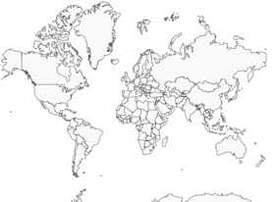Cape Verde Warbler
Acrocephalus brevipennis - Rousserolle du Cap-Vert
Identification
The Cape Verde Warbler is quite different from our European reed warblers. In terms of both appearance and behavior, it more closely resembles a grasshopper warbler. Its size appears slightly bigger than a chiffchaff, but without direct comparison, it is not easy to appreciate. The outermost primary projection is very short, with only 6 primaries visible, each edged with a light terminal border. This feature coupled with the very short undertail coverts, gives the appearance of a long tail, especially as the latter is not very rounded at the end. In the adult, the upper parts are a dull greyish-brown, rather uniform. The underparts are dirty white, tinged with grey-beige. The undertail coverts are white. The overall look is "cold". The head has a short white eyebrow in front of the eye, in contrast to the darkened crown line. But because the loral line is not so apparent, the face is not very distinct. The neck appears long, though only in certain poses. The bill is yellow with a dark culmen. The legs are greyish-blue. As for all Acrocephalus, the juvenile plumage is said to be warmer, more rufous on the topside, and with a yellowish hue on the underside.
Subspecific information monotypic species
Foreign names
- Rousserolle du Cap-Vert,
- Carricero de Cabo Verde,
- chota-de-cana,
- Kapverdenrohrsänger,
- zöld-foki nádiposzáta,
- Kaapverdische Rietzanger,
- Cannaiola di Capo Verde,
- kapverdesångare,
- Kappverdesanger,
- trsteniarik krátkokrídly,
- rákosník kapverdský,
- Kap Verde-rørsanger,
- kapverdenkerttunen,
- boscarla de Cap Verd,
- Kjarrsöngvari,
- trzciniak wyspowy,
- Kaboverdes ķauķis,
- zelenortska trstnica,
- Короткопёрая камышевка,
- ケープベルデアシナガヨシキリ,
- 佛得角苇莺,
- kapverdesångare,
- 甘蔗葦鶯,
Voice song and call
The song of the Cape Verde Warbler is highly variable. It is quite different from that of our European warblers. It is deep and rolling patterns that evoke the nightingale. An amphibian tone is also evoked. The most frequent call is a single or two-syllable ouac or touic, low and slightly rough in tone. It is very typical but short-lived. There is also a croaking churrr.
Habitat
The Cape Verde Warbler has a preference for lush, humid, low-strata vegetation that is sometimes dense, interspersed with open, grassy, or even barren areas. On Santiago, its current stalwart, it can be found in the heart of the island, from low altitude valleys to mountainous valleys beyond 1000 m. In the valley it is found in the lush vegetation of river banks, on the edges of cultivated fields, banana plantations, and sugar cane plantations. This environment is often lush and hard to penetrate, making the search for the warbler difficult. The presence of tall cane, Arundo donax, is appreciated but not necessary. On hillsides, the habitat may be more open in less deep soil. At higher altitude, it occupies the maquis found in valleys, in the sub-layer of eucalyptus forests, where there is a high level of cloud cover; for example, beyond 1200 m near the Monte Chota radio station.
Behaviour character trait
As a good Acrocephalus, the Cape Verde Warbler is attracted by water which is a frequent component of its habitat. One can see it looking for its food by the water's edge, like a reed warbler. It even ventures onto floating objects, just like a Chiffchaff. Most of the time, however, its movements in the dense, both herbaceous and woody vegetation, escape observation. But if one knows its voice, it can easily be spotted in its tangled vegetation. As mentioned above, it also recall a Woodlark due to its way of calmly exploring the bushes or trees. It is not shy. From time to time it appears in the open and it is the perfect chance to observe it or take a photograph. When it builds or feeds, it does not hesitate to fly tens of meters in a low and direct flight.
Flight
Its short wings don't allow it to fly over long distances, and it's perfectly sedentary. However, they are very useful to evolve in the dense vegetation of its habitat. When flying from one perch to another, it lands at the end of a short planing flight, in a way similar to an Icterine Warbler.
Dietfeeding habits
The species is known to be insectivorous. It has been observed hunting near water. This element clearly plays an important role in its search for food.
Reproduction nesting
The Cape Verde Warbler breeds in late summer and autumn, but the timing can be influenced by the rainfall. Breeding may begin as early as July and last until March, allowing for a potential second clutch when the conditions are right. The nest is made in the large herbaceous plant Arundo donax, as well as in woody shrubs and trees up to 10 meters in height. The nest is large for the size of the bird, conical and woven. It resembles that of the Golden Oriole. 2 to 3 egg clutches have been recorded.
Geographic range
Threats - protection
IUCN conservation status
concern
in the Wild
threatened
evaluated
On Santiago, the Cape Verde Warbler species is widely distributed and takes up all suitable habitats. It does not appear to be threatened in the immediate future. However, its status as an endemic island species could make it vulnerable to changes in its environment (climate change, development and improvement of agricultural operations). On the other hand, its status on Sao Nicolau is necessarily more precarious. However, monitoring conducted a few years after its rediscovery showed the apparent stability of the small population. Nevertheless, it would be wise to anticipate any potential future decline by developing the irrigation system and encouraging the planting of fruit trees and canes.
Sources of information
- IOC World Bird List (v14.2), Gill, F and D Donsker (Eds). 2024-04-18.
- Birds of the Atlantic Islands, Clarke Tony
- Birds of the Western Paleartic interactive, Cramp Simmons
Other sources of interest
 Specification sheet created on
28/07/2023 by Jean François
Specification sheet created on
28/07/2023 by Jean FrançoisTranslation by AI Oiseaux.net
© 1996-2025 Oiseaux.net
- Accipitriformes
- Aegotheliformes
- Anseriformes
- Apodiformes
- Apterygiformes
- Bucerotiformes
- Caprimulgiformes
- Cariamiformes
- Casuariiformes
- Charadriiformes
- Ciconiiformes
- Coliiformes
- Columbiformes
- Coraciiformes
- Cuculiformes
- Eurypygiformes
- Falconiformes
- Galliformes
- Gaviiformes
- Gruiformes
- Leptosomiformes
- Mesitornithiformes
- Musophagiformes
- Nyctibiiformes
- Opisthocomiformes
- Otidiformes
- Passeriformes
- Pelecaniformes
- Phaethontiformes
- Phoenicopteriformes
- Piciformes
- Podargiformes
- Podicipediformes
- Procellariiformes
- Psittaciformes
- Pterocliformes
- Rheiformes
- Sphenisciformes
- Steatornithiformes
- Strigiformes
- Struthioniformes
- Suliformes
- Tinamiformes
- Trogoniformes

